The aim of our behaviour change project was to encourage students at the University of Warwick to drink more water. An infographic was produced detailing the benefits of drinking more water with advice on how much you should drink and student relevant benefits to drinking more water. At the bottom of the infographic students were asked to pledge to drink more water.These leaflets were handed out to students outside the library on the University of Warwick campus to more than 50 students. The researchers dispensed these leaflets during peak times (just before each hour when students were moving from lecture to lecture). When we approached the students we asked them a few questions about their water intake, and then asked them if they knew the benefits of drinking more water before providing them with the leaflet. Then participants were asked again to pledge to drink more water. By using a combination of credible sources and just asking the researchers encouraged people to drink more water. Whilst we didn’t measure if water consumption increased, it would be possible to do so by asking students to fill out a water diary for a week and comparing this to baseline levels. Overall responses to the leaflet were very positive with a large amount of students that were approached agreeing to drink more water. Emma PhillipsVictoria Pattinson
By using a combination of credible sources and just asking the researchers encouraged people to drink more water. Whilst we didn’t measure if water consumption increased, it would be possible to do so by asking students to fill out a water diary for a week and comparing this to baseline levels. Overall responses to the leaflet were very positive with a large amount of students that were approached agreeing to drink more water. Emma PhillipsVictoria Pattinson
Reducing Missed Appointments at the Health Centre
The aim of our project was to reduce the number of missed appointments at the Health Centre due to an increasing number of students missing appointments. We created 2 posters (image 1 and 2), which featured a variety of persuasive techniques. These posters were shared on university facebook groups (image 3), as well as around the university in week 9, where most Warwick students could see them. The number of missed appointments was slightly lower from week 9 to week 10, meaning our project made a slight difference.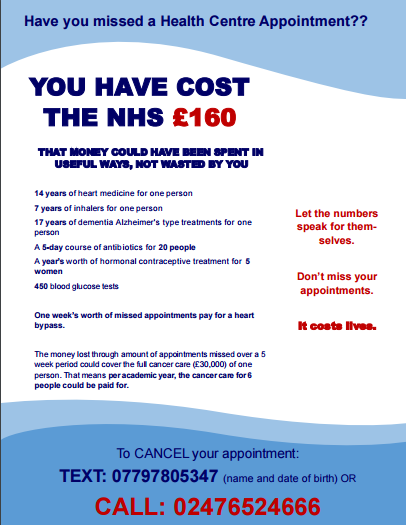 Image 1: Have you missed a Health Centre appointment?
Image 1: Have you missed a Health Centre appointment?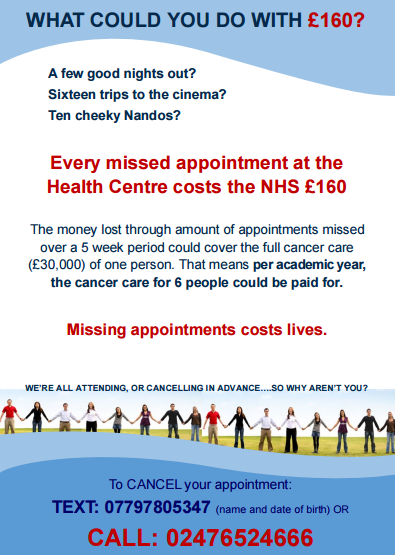 Image 2: What could you do with £160?On social media the posters were displayed with the following captions:HAVE YOU MISSED A HEALTH CENTRE APPOINTMENT? To cancel, simply call or text in advance! Missing appointments costs lives.WHAT COULD YOU DO WITH £160? Every missed health centre apponitment costs the NHS £160. To cancel, simply call or text in advance! Missing appointments costs lives.
Image 2: What could you do with £160?On social media the posters were displayed with the following captions:HAVE YOU MISSED A HEALTH CENTRE APPOINTMENT? To cancel, simply call or text in advance! Missing appointments costs lives.WHAT COULD YOU DO WITH £160? Every missed health centre apponitment costs the NHS £160. To cancel, simply call or text in advance! Missing appointments costs lives.
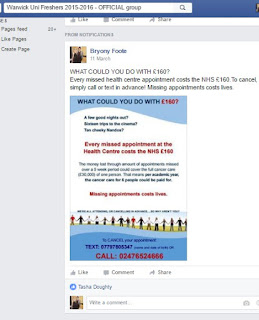 Image 3: Screenshots from University of Warwick Freshers Facebook groupOur posters also used data on the NHS medicine costs (data from Regional Drug & Therapeutics Centre Newcastle, 2015), in order to make non-attenders feel guilty about the impact of missed appointments (e.g. stating the £160 could pay for “7 years of inhalers for one person”).Using missed appointment data provided by the University of Warwick Health Centre, we found that missed appointments decreased by a small amount (1 hour) in the week after our posters were displayed. Therefore, our poster campaign may have had a slight effect on total missed appointment time.ReferencesHallsworth, M., Berry, D., Sanders, M., Sallis, A., King, D., Vlaev, I., & Darzi, A. (2015). Stating appointment costs in SMS reminders reduces missed hospital appointments: Findings from two randomised controlled trials. PLoS One, 10 (9): e0137306. doi:10.137/journal.pone.0137306 Regional Drug and Therapeutics Centre (Newcastle). (2015). Cost comparison charts, Retrieved from http://gmmmg.nhs.uk/docs/cost_comparison_charts.pdf.Bryony FooteNatasha DoughtyLuca VillaOwain Ritchie
Image 3: Screenshots from University of Warwick Freshers Facebook groupOur posters also used data on the NHS medicine costs (data from Regional Drug & Therapeutics Centre Newcastle, 2015), in order to make non-attenders feel guilty about the impact of missed appointments (e.g. stating the £160 could pay for “7 years of inhalers for one person”).Using missed appointment data provided by the University of Warwick Health Centre, we found that missed appointments decreased by a small amount (1 hour) in the week after our posters were displayed. Therefore, our poster campaign may have had a slight effect on total missed appointment time.ReferencesHallsworth, M., Berry, D., Sanders, M., Sallis, A., King, D., Vlaev, I., & Darzi, A. (2015). Stating appointment costs in SMS reminders reduces missed hospital appointments: Findings from two randomised controlled trials. PLoS One, 10 (9): e0137306. doi:10.137/journal.pone.0137306 Regional Drug and Therapeutics Centre (Newcastle). (2015). Cost comparison charts, Retrieved from http://gmmmg.nhs.uk/docs/cost_comparison_charts.pdf.Bryony FooteNatasha DoughtyLuca VillaOwain Ritchie
Do you always wash your hands before you eat?
It’s a basic hygiene practice that you will probably ignore because the washroom is simply too far away from the cafe till. So we decided to make it more convenient for you, and push for a petition to place hand sanitisers in all eateries within the Warwick Campus.Why hand sanitisation is important:Hand hygiene is found to significantly reduce gastrointestinal illness and even respiratory illness (Aiello, Coulborn, Peres & Larson, 2008). Although there hasn’t been any major case of infectious illness on campus, we felt that we should not wait for it to happen before the university take action. Evidence has shown that placing hand sanitisers at convenient places around school campuses have reduced illness rates and absenteeism (White et al., 2003). So why not cultivate such hygiene practices in Warwick too?How we did it:In order to see the effectiveness of adding a hand sanitiser to food outlets, we hosted a bake sale (raising money for Breast Cancer Now and Coppafeel). We got people to come to our bake sale via Facebook: And what we made for our bake sale:
And what we made for our bake sale: A hand sanitiser was placed on the table alongside the food and it was free for anyone to use. This will serve as a platform for us to ask for their support in signing the petition for making hand sanitisers available in all Warwick food outlets. In a bid to get people to notice and use the hand sanitisers (technique: availability heuristics/salience), we attached signs to the hand sanitisers, which we alternate from time to time in order to see which type of sign would be the ost effective at changing participants behaviour.Sign 1: No sign attached (Control)Sign 2: Salience
A hand sanitiser was placed on the table alongside the food and it was free for anyone to use. This will serve as a platform for us to ask for their support in signing the petition for making hand sanitisers available in all Warwick food outlets. In a bid to get people to notice and use the hand sanitisers (technique: availability heuristics/salience), we attached signs to the hand sanitisers, which we alternate from time to time in order to see which type of sign would be the ost effective at changing participants behaviour.Sign 1: No sign attached (Control)Sign 2: Salience Sign 3: Informative
Sign 3: Informative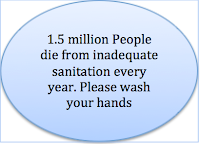 We used the door-in-the-face technique to get them to sign the petition. For those who used the hand sanitisers, we thank them for using it. We then proceed with the first request: we asked them whether they would be willing to become an ambassador for Warwick hygiene (fictional), which requires training every month for a year. Our second request was to have them sign a petition now for making hand sanitisers available in all campus eateries. Results:We found that when there was no sign attached to the hand sanitiser, only 10% of those who approached our till used it. However, when the hand sanitiser was attached with an inviting sign (sign 2), 45% of those approached used it. It further increased to 75% when the sign was informative (sign 3). As expected, no one was willing to accept the first request of becoming a hygiene ambassador citing busy schedules. They all agreed to the second request of signing the petition. Petition:
We used the door-in-the-face technique to get them to sign the petition. For those who used the hand sanitisers, we thank them for using it. We then proceed with the first request: we asked them whether they would be willing to become an ambassador for Warwick hygiene (fictional), which requires training every month for a year. Our second request was to have them sign a petition now for making hand sanitisers available in all campus eateries. Results:We found that when there was no sign attached to the hand sanitiser, only 10% of those who approached our till used it. However, when the hand sanitiser was attached with an inviting sign (sign 2), 45% of those approached used it. It further increased to 75% when the sign was informative (sign 3). As expected, no one was willing to accept the first request of becoming a hygiene ambassador citing busy schedules. They all agreed to the second request of signing the petition. Petition: Signatures:
Signatures: Due to confidentiality purposes, student details of those who signed are not posted up here on the blog. However, we have included them to our email to the commercial operations director as proof that the signatures are by university staff and students. We also filled in a “start a campaign” form on the su website. Here is the email we sent to the commercial operations director:
Due to confidentiality purposes, student details of those who signed are not posted up here on the blog. However, we have included them to our email to the commercial operations director as proof that the signatures are by university staff and students. We also filled in a “start a campaign” form on the su website. Here is the email we sent to the commercial operations director: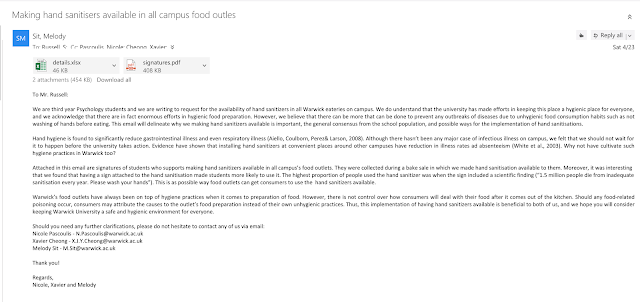 ** Update as of 28 April 2016:We have received an email back from the Campaign Coordinator who informed us he has taken action to introduce hand sanitisers in SU-owned food outlets!
** Update as of 28 April 2016:We have received an email back from the Campaign Coordinator who informed us he has taken action to introduce hand sanitisers in SU-owned food outlets! And true enough, here’s one from Xananas:
And true enough, here’s one from Xananas: Although they had their reasons not to place the informative sign we suggested, they were willing to put on this inviting sign.You can now have clean hands to eat on campus now!- Nicole Pascoulis- Melody Sit- Xavier CheongReferences:Aiello, A.E., Coulborn, R.M., Perez, V.P., & Larson, E.L. (2008). Effect of hand hygiene on infectious deisease risk in the community setting: A meta-analysis, American Journal of Public Health, 98(8), 1372-1381.Jónsdóttir, H.L., Holm, J.E., Poltavski, D., & Vogeltanz-Holm, N. (2014) The role of fear and disgust in predicting the effectiveness of television advertisments that graphically depict the health harms of smoking, Preventing Chronic Disease, 11.White, C., Kolble, R., Carlson, R., Lipson, N., Dolan, M. Ali, Y., Cline, M. (2003). The effect offhand hygiene on illness rate among students in university residence halls, American Journal Of Infection Control, 31(6), 364-370
Although they had their reasons not to place the informative sign we suggested, they were willing to put on this inviting sign.You can now have clean hands to eat on campus now!- Nicole Pascoulis- Melody Sit- Xavier CheongReferences:Aiello, A.E., Coulborn, R.M., Perez, V.P., & Larson, E.L. (2008). Effect of hand hygiene on infectious deisease risk in the community setting: A meta-analysis, American Journal of Public Health, 98(8), 1372-1381.Jónsdóttir, H.L., Holm, J.E., Poltavski, D., & Vogeltanz-Holm, N. (2014) The role of fear and disgust in predicting the effectiveness of television advertisments that graphically depict the health harms of smoking, Preventing Chronic Disease, 11.White, C., Kolble, R., Carlson, R., Lipson, N., Dolan, M. Ali, Y., Cline, M. (2003). The effect offhand hygiene on illness rate among students in university residence halls, American Journal Of Infection Control, 31(6), 364-370
- « Previous Page
- 1
- …
- 19
- 20
- 21
- 22
- 23
- …
- 25
- Next Page »